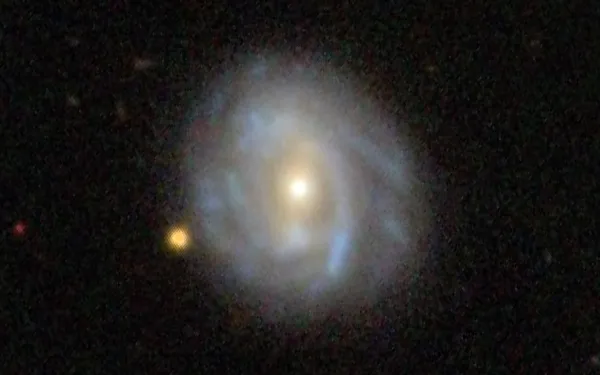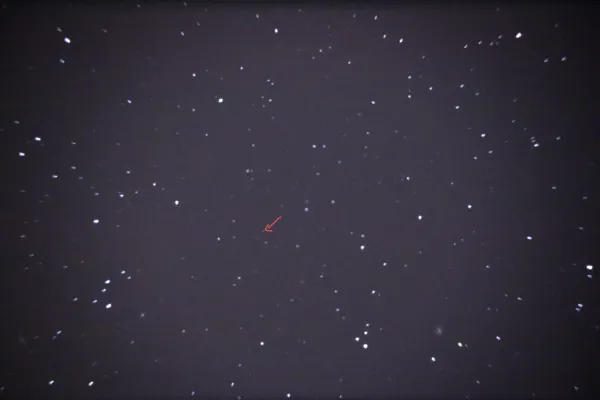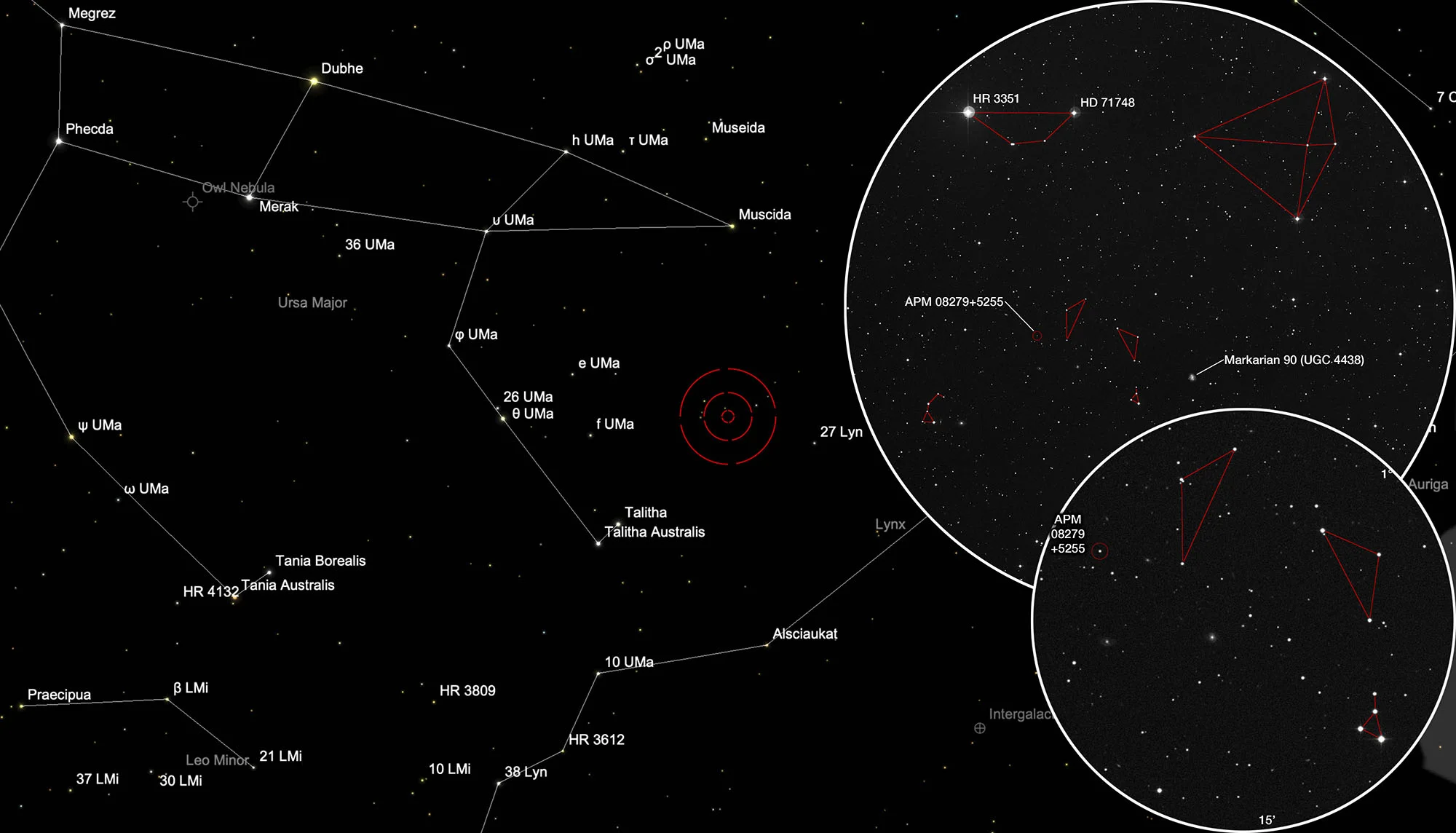Quasar APM 08279+5255 & Galaxy Markarian 90

History
The quasar APM 08279+5255 was identified in 1998 by Michael J. Irwin et al. They were doing spectroscopic observations as part of the Automatic Plate Measuring Facility (APM) survey to identify distant cool carbon stars in the Galactic halo. This observation was conducted with the 2.5 m Isaac Newton Telescope (INT) at the Roque de los Muchachos Observatory, La Palma. One of the observations turned out to be a extremely bright BAL (broad absorption line) quasar with a redshift of z close to 4. The quasar was positionally coincident with the infrared source IRAS F08279+5255. [462]
Physical Properties
Existing studies suggest that APM 08279+5255 is a rare starbursting quasar, in which both the AGN (active galactic nucleus) and host galaxy are undergoing extremely active phases. Gravitational lensing of an unobserved foreground galaxy causes a magnification of a factor 4-100 times. The quasar has a bolometric luminosity of more than 5×1015 that of the sun, which makes it one of the brightest objects in the universe. Due to its extreme brightness, it is one of the best-studied high redshift objects (z = 3.9114). Photometric measurements with the Stratospheric Observatory for Infrared Astronomy (SOFIA) and the Spitzer Space Telescope suggest the quasar is surrounded by a dusty torus with an inclination angle of about 15° [468]
Observations with the Chandra X-Ray Observatory revealed evidence of high-speed winds that are blowing gas away from the supermassive black hole in the centre of APM 08279+5255. These winds reach 40% of the speed of light, considerably faster than predicted. Gas that swirls in a disk towards the black hole is heated to millions of Kelvins and produces intense X-radiation. The pressure of the X-rays pushes matter away from the inner part of the disk, which can significantly limit the amount of matter captured by the black hole. The double image of APM 08279+5255 shown in Fig. 1 is caused by gravitational lensing. Distance is estimated to 12 billion light years, making it one of the youngest objects in the visible universe. [469]
The quasars magnitudes in the visible spectrum according to Simbad [145] are: B (445 nm) 19.2 mag, G (464 nm) 17.31 mag, R (658 nm) 14.5 mag — hence within visual reach of large amateur telescopes.
| Name | APM 08279+5255 |
| Object Type | Quasar |
| Right Ascension (J2000.0) | 08h 31m 42s |
| Declination (J2000.0) | +52° 45' 18" |
| Radial velocity | 275922 km/s |
| Redshift z | 3.911 |
| Magnitudes | B 19.2; G 16.20409; R 14.5; I 13.9; J 13.41; H 12.661; K 12.05; u 24.237; g 17.31; r 15.387; i 14.864; z 14.639 |
| Identifiers | 2MASS J08314169+5245174; 2XMM J083141.6+524517; 3XMM J083141.7+524517; FIRST J083141.6+524517; Gaia DR2 1028742871820206336; Gaia DR3 1028742871820608896; IRAS F08279+5255; JCMTSE J083141.9+524518; JCMTSF J083141.3+524518; KODIAQ J083141+524517; NAME APM 0827+525; NAME APM 08279+5255; PSO J127.9237+52.7548; QSO B0827+5255; QSO B0827+529; QSO B0827.9+5255; QSO J0831+5245; SDSS J083141.70+524517.5; TIC 71213405; WISEA J083141.69+524517.5; [VV2000] J083141.6+524518; [VV2003] J083141.6+524518; [VV2006] J083141.6+524518; [VV2010] J083141.6+524518 |
Galaxy Markarian 90 (UGC 4438)

While hunting down one of the youngest objects in the universe you may come across the spiral galaxy Markarian 90 (Mrk 90, UGC 4438). The galaxy was discovered by the Armenian astrophysicist Benjamin Markarian. He published multiple series of Galaxies with an ultraviolet continuum from the years 1967 through 1981. The observations were made using the 40-52 inch Schmidt telescope of the Byurakan Astrophysical Observatory. [470, 471] The galaxy has nothing to do with the gravitational lensing of the quasar. It is a source of radio radiation. According to HyperLEDA [134] the galaxy is of morphological type SBbc and has a mean heliocentric radial velocity of 4246 ± 2 km/s. On 21 March 1987 the supernova SN 1987C hosted by this galaxy was discovered. However, it reached only 17.5 mag. [303]
| Designations | PGC 23850: UGC 4438, MCG 9-14-47, MK 90, CGCG 263-40, IRAS 8262+5251, ANON 826+52 |
| Right Ascension (J2000.0) | 08h 29m 59.6s |
| Declination (J2000.0) | +52° 41' 49" |
| Morphological Type | S |
| Dimensions | .7' x .7' |
| Visual Magnitude | 14.0 mag |
| Radial Velocity (HRV) | 4279 km/s |
| Position Angle | 15° |
Finder Chart
The quasar APM 08279+5255 is located in the constellation Lynx, between the paws and the head of the Great Bear (Ursa Maior). The figures of brighter stars drawn in the 1° DSS section should be helpful in identifying this rather difficult object. The bright trapezoid with the stars HR 3351 and HD 71748 serves as an entry point. On 26 January it is in opposition to the Sun and crosses the meridian at local midnight. From October to June the quasar is highest in the night sky.
Visual Observation
400 mm Aperture: The position of the quasar can already be clearly determined at low magnification (21 mm Tele Vue Ethos, 85x) using the conspicuous star figures on the location map. At higher magnification (11 mm DeLite, 163x) only the surrounding stars are visible. The quasar itself remains hidden. possibly it would be crackable under an even darker sky with extremely calm air. The galaxy Markarian 90 (UGC 4438) is only noticeable in the 21 mm Ethos with averted viewing. At higher magnifications, it is directly visible as an oval nebula with a star-like core. — Taurus T400 f/4.5 Dobsonian, Glaubenberg, 25. March 2022, 22:00 CET, SQM-L 21.1, Bernd Nies

762 mm aperture: Too small an offset was chosen with the Telrad, which in turn led to a very long search for the correct object position. For hours there was no star pattern to start star hopping. When a star pattern was finally found, time was well advanced to astronomical twilight. But now quickly advance to the actual position of the quasar by means of star hopping and take a photo by connecting a camera and evaluate it immediately on site, or in modern terms: Electronic Assisted Astronomy, EAA for short. Record: 12 billion light years have at least been covered by EAA.
After the learning phase of the last observation night, finding the quasar position today turned out to be easy and clear. The faint dot of light flashed three or four times shortly after starting to look. The respective confirmations after the flashing were not successful and after a long (also indirect) look, the perception tended to decrease again. Therefore capture EAA or the quasar again on the photochip with a short exposure time and, after immediate evaluation, clearly identify it on the screen of the camera attached to the big Dobsonian.
